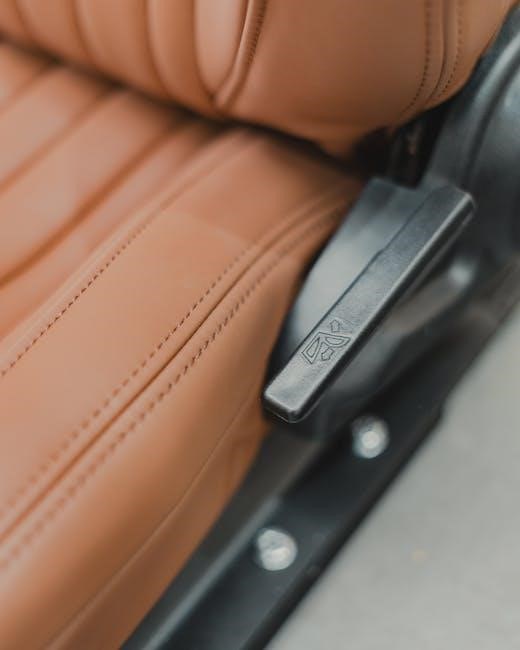Jump-N-Carry JNC660 Manual: A Comprehensive Guide
The Jump-N-Carry JNC660 is a popular jump starter; This guide provides you with comprehensive information regarding the JNC660. This includes key features, charging, jump-starting procedures, safety, and troubleshooting. Find out how to recycle and locate the manual.
Overview of the Jump-N-Carry JNC660

The Jump-N-Carry JNC660 is a 1700 Peak Amp 12 Volt jump starter by Clore Automotive, designed for automotive service garages, car dealerships, towing operations and busy fleet facilities. It’s also suitable for consumers who desire professional-grade equipment.
This jump starter is powerful, portable, and versatile. It is designed to handle challenging conditions, such as extremely cold weather. The JNC660 is more than just a jump starter. It also features a 12-volt power outlet. This outlet is designed for powering additional items, for example work lights and power tools.
The JNC660’s internal charger facilitates convenient recharging, with the recommended method being AC power via a household extension cord. An alternative charging method uses the DC power outlet with the provided 12 Volt Male-Male Extension Cord. Always ensure the unit is fully charged before use and after each use.

The JNC660 is a reliable device designed for jump-starting vehicles. With a peak current rating of 1700 amps, it can easily jump-start large batteries found in trucks and SUVs.
Key Features and Specifications
The Jump-N-Carry JNC660 boasts a robust set of features and specifications that make it a reliable and powerful jump starter. Its 1700 Peak Amps and 425 Cranking Amps provide ample power to jump-start various vehicles, including cars, trucks, boats, and SUVs.
Equipped with a 12-volt power outlet, the JNC660 doubles as a portable power supply for running accessories like work lights or small power tools. The built-in charger allows for convenient recharging using a standard household extension cord. For alternative charging, a 12 Volt Male-Male Extension Cord can be used via the DC power outlet.
The JNC660 is designed for durability and portability. Its compact design ensures it can be easily transported and stored. The rugged construction ensures it can withstand demanding environments.
Key specifications include its 12-volt DC output, internal charging capability, and high amperage output for effective jump-starting. These features combine to make the JNC660 a versatile tool for both professional mechanics and everyday users.
Charging Instructions and Maintenance
To ensure optimal performance and longevity of your Jump-N-Carry JNC660, proper charging and maintenance are crucial. Upon initial use, charge the unit for a full 24 hours using the built-in charger and a standard household extension cord. This initial charge ensures the battery reaches its maximum capacity.
After each use, it is essential to recharge the JNC660 to maintain its readiness for the next jump-start. Regular charging prevents the battery from deep-discharging. Deep-discharging can significantly reduce its lifespan. Also, before extended storage, fully charge the unit.
For routine charging, connect the JNC660 to an AC power source using an extension cord. Alternatively, use the provided 12 Volt Male-Male Extension Cord via the DC power outlet. Monitor the charging process to avoid overcharging. Overcharging can also damage the battery.
Proper maintenance includes keeping the unit clean and dry. Inspect the clamps and cables regularly for damage. Replace any worn or damaged parts promptly. Store the JNC660 in a cool, dry place to maximize battery life.
Jump Starting Procedure: Step-by-Step Guide
Follow these steps carefully to jump-start a vehicle using the Jump-N-Carry JNC660. First, review the JNC660’s manual, along with the vehicle manufacturer’s safety guidelines. Ensure both the JNC660 and the vehicle are turned off before beginning.
Next, attach the red (positive) clamp of the JNC660 to the positive terminal of the vehicle’s battery. Then, connect the black (negative) clamp to a clean, unpainted metal surface on the vehicle’s frame, away from the battery and fuel lines.
Once the clamps are securely attached, turn on the JNC660. Now, attempt to start the vehicle. If the vehicle doesn’t start immediately, wait a few minutes and try again. Avoid prolonged cranking, which can damage the starter.
After the vehicle starts, disconnect the negative clamp first, followed by the positive clamp. Store the JNC660 safely. Finally, recharge the JNC660 as soon as possible to ensure it’s ready for the next use. Following these steps will ensure a safe and effective jump-start.
Using the 12-Volt Power Outlet
The Jump-N-Carry JNC660 features a convenient 12-volt power outlet, enhancing its versatility beyond jump-starting. This outlet allows you to power various DC devices, such as work lights, mobile phones, and small power tools, making it useful in many situations.
To use the 12-volt power outlet, ensure the JNC660 is fully charged. Locate the outlet on the unit, typically covered by a protective cap. Remove the cap and insert the 12-volt accessory plug into the outlet, ensuring a secure fit.
Once connected, turn on the JNC660 to supply power to the connected device. Monitor the device’s power consumption to avoid overloading the JNC660. The maximum amperage the outlet can handle is specified in the manual.
After use, turn off the JNC660 and disconnect the device. Replace the protective cap on the 12-volt outlet to prevent dust and debris from entering. Regularly check the outlet for damage and clean it as needed. Proper use ensures longevity and reliable performance.
Safety Precautions and Warnings
Using the Jump-N-Carry JNC660 safely requires adherence to precautions. Always review the manual and the vehicle’s manual before jump-starting. Never jump-start a vehicle in an enclosed area due to explosive gases. Wear eye protection to prevent battery acid exposure.
Ensure the JNC660 is used in a well-ventilated area. Keep it away from flammable materials. Verify the voltage of the JNC660 matches the vehicle’s battery. Incorrect voltage can damage the vehicle’s electrical system. Connect clamps correctly: red to positive (+), black to negative (-).
Avoid touching the clamps together while the JNC660 is on. This can cause sparks and damage the unit. Disconnect the JNC660 immediately after starting the vehicle. Do not leave it connected for extended periods.
If the vehicle does not start after a few attempts, consult a professional mechanic. Overheating can occur with repeated jump-starting attempts. Store the JNC660 in a cool, dry place. Keep it out of reach of children. Regularly inspect the cables and clamps for damage.
Troubleshooting Common Issues
If the JNC660 fails to start a vehicle, first check the charge level. A low battery can prevent jump-starting. Ensure the clamps are securely connected to the battery terminals. Poor connections can hinder the flow of power. Verify the polarity is correct: red to positive, black to negative. Reversed polarity can damage the vehicle.
If the JNC660 turns on but doesn’t deliver power, inspect the internal fuse. A blown fuse can interrupt the circuit. Replace it with a fuse of the same rating. If the unit still doesn’t work, the battery might be faulty. Consider replacing the internal battery.
If the JNC660 doesn’t charge, check the AC charging cable. Ensure it’s properly connected to both the unit and a working outlet. If charging via DC, verify the 12V outlet is functional.
If the unit displays error messages, consult the manual for specific meanings. Overheating can trigger error codes. Allow the unit to cool down before attempting to use it again. For persistent issues, contact customer support.

Battery Replacement Information
Replacing the battery in your JNC660 can extend its lifespan. First, ensure the unit is disconnected from any power source and turned off. Locate the battery compartment, typically on the back or bottom of the unit. Remove the screws securing the compartment cover. Carefully open the compartment, noting the battery’s polarity.
Disconnect the battery terminals, usually connected with spade connectors. Take a picture of the wiring configuration before disconnecting anything. Replace the old battery with a new one of the same type and voltage. Ensure the new battery is compatible with the JNC660.
Connect the terminals to the new battery, matching the polarity. Secure the battery in the compartment and replace the cover. Screw the cover back into place tightly.
After replacing the battery, charge the JNC660 for the recommended time before using it. Properly dispose of the old battery according to local regulations. Incorrect disposal can harm the environment. If unsure about any step, seek professional assistance.
Recycling and Disposal Guidelines
Proper recycling and disposal of the JNC660 are essential for environmental protection. The JNC660 contains a lead-acid battery, which requires careful handling. Do not dispose of the unit or its battery in regular trash. Lead-acid batteries contain hazardous materials that can contaminate soil and water.
Check with your local municipality or waste management services for designated collection points. Many auto parts stores and recycling centers accept lead-acid batteries for recycling. Before disposal, ensure the battery terminals are protected to prevent short circuits.
Consider covering the terminals with electrical tape. Transport the battery in an upright position to avoid leaks. When handing it over to a recycling facility, inform them it is a lead-acid battery. They will ensure it’s processed correctly.
Recycling recovers valuable materials like lead and plastic. This reduces the need for new resources. Following these guidelines helps protect the environment and promotes sustainability. Always adhere to local regulations for battery disposal. Contact your local environmental agency for further information.
Where to Find the JNC660 Manual
Accessing the JNC660 manual is straightforward. It is available in several formats for your convenience. If you purchased the JNC660 new, the manual is included in the product packaging. Check the box contents carefully upon unboxing.
The manual can also be found online. Visit the Clore Automotive website, the manufacturer of the JNC660. Navigate to the support or downloads section. Search for the JNC660 product page to locate the manual in PDF format.

Many online retailers that sell the JNC660 also provide a link to the manual on their product pages. Websites specializing in manuals and user guides often host the JNC660 manual. A simple internet search for “JNC660 manual” will yield numerous results.
Ensure you download the correct manual version for your specific JNC660 model. The manual is typically available in English. Some sites offer it in multiple languages. Download the PDF and save it to your device for easy access. You can then print it if you prefer a hard copy.




Leave a Reply
You must be logged in to post a comment.